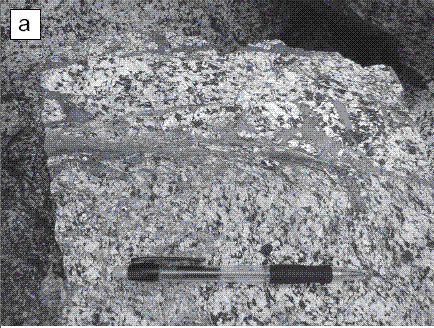Geologists have previously debated whether these rocks are rarely produced or not based on an apparent absence in the rock record, most likely brought about by the difficulty in identifying them. Only a small fraction of the energy released in an earthquake is consumed by seismic waves, the formation of pseudotachylytes reveals the importance of the heat generated by the earthquake process.

The Seven Gables Trail fault, Big Bear fault and East Branch fault contain 1 to 6mm thick, dark grey to black pseudotachylytes often displaying banding. See notes at
Pseudotachylytes form by frictional melting during co-seismic faulting at significant depths in the crust. They are not easy to identify, requiring evidence that the fault rock has passed through a melt phase. They are generated by frictional heating of the slip surface, the melting of which may account for a significant proportion of energy released during an earthquake.
Past surveys of the Sierra Nevada, which reported an absence of pseudotachylytes, have focused on the geometry and mechanics of the faults rather than the geological details of the rock types and composition. However, the authors of this study report an abundance of pseudotachylytes throughout the area. The pseudotachylytes they describe range from easily identified to impossible to identify from field data alone. The authors suggest further study of pseudotachylytes will ultimately reveal more about energy partitioning during earthquakes.
Article: "Pseudotachylytes; rarely generated, rarely preserved or rarely reported?" , James D. Kirkpatrick, Zoe K. Shipton and Cristina Persano, 'Bulletin of the Seismological Society of America, February 2009





Comments